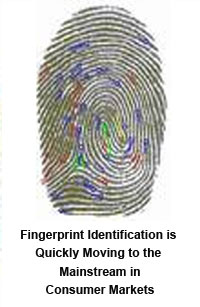SCDigest
Editorial Staff
The News: Long
a staple of futuristic movies, “Biometric”
Identification of consumers has gone from
Hollywood
to mainstream in just a couple of years,
as theme parks and grocery store payment
systems sprout from California
to Dayton,
OH.
|
SC Digest Says: |
 Fingerprints
might someday be used to check in and
off the job, eliminating the “time
clock fraud” that sometimes occurs
when other workers punch in or out for
an employee.
Fingerprints
might someday be used to check in and
off the job, eliminating the “time
clock fraud” that sometimes occurs
when other workers punch in or out for
an employee. 
What do you say?
Send
us your comments here |
The Impact: There
has always been a great amount of interest
– and fear – about systems which
would identify humans based on biological
signals (fingerprints, retina scans, etc.),
but it always seemed more sci-fi than real.
With the growing prevalence of biometric
systems in the market, however, have we
reached a point of critical mass where they
will soon be commonplace? Or will privacy
concerns emerge that throttle further development
at some point?
The Story: “Biometrics”
are automated methods of recognizing a person
based on a physiological or behavioral characteristic.
Among the features measured are face, fingerprints,
hand geometry, handwriting, iris, retinal,
vein, and voice.
As the Biometric
Consortium (http://www.biometrics.org/)
web site notes: “Biometric technologies
are becoming the foundation of an extensive
array of highly secure identification and
personal verification solutions. As the
level of security breaches and transaction
fraud increases, the need for highly secure
identification and personal verification
technologies is becoming apparent.”
In
recent years, theme parks such as Disney
World and Universal Studios in Orlando
have rolled out fingerprint-based systems
designed to eliminate the ability of visitors
to sell or give away admission tickets to
another consumer when their visit is over.
For example,
in the past, a Universal Studios guest purchasing
a multi-day ticket admission ticket could
use the ticket for a few days, and then sell
the ticket for the remaining days admission
to someone else. The
new system requires the guest to have their
fingerprint (generally, the right index
finger) scanned when they first enter the
park. That image is tied to the serial number
of the admission ticket. Subsequent admissions
require the process to be repeated, and
if the fingerprint in the database doesn’t
match the one tied to the ticket ID, admission
would be refused.
Related biometric
technology has also moved into grocery store
payment systems. A growing number of grocers,
such as Jewel-Osco, Cub Foods, Piggly Wiggly
and Harris Teeter have rolled out pilot
or production systems in at least some parts
of their chains from a company called Pay
by Touch. With that system, after a
consumer registers with the system, they
can pay for their groceries simply by having
their fingerprint scanned at an in-store
kiosk. No credit cards, check, cash or driver’s
license required – you wouldn’t
need to carry a wallet or purse to buy groceries.
BioPay
is another company in the space, once
a rival provider to Pay by Touch but acquired
by the company is 2005.

Dorothy
Lane Markets, an upscale, three-store chain
in the Dayton,
OH
area, is now rolling out the Pay-By-Touch
system in all three of its stores. In the
past, the small chain has often been used
by Dayton-based NCR Corp. to test new retail
technologies.
Tom Jackson,
President and Chief Executive Officer of
the Ohio Grocers' Association, said the
new Pay By Touch or similar system is more
secure than traditional payment methods.
"Our
fingerprint, or our retina, it's indigenous
and unique to us, so therefore, that adds
to the security that the person who's supposed
to be using this charge is in fact the person
who should be," he said.
But
will consumers or privacy groups generate
any backlash against private companies amassing
huge databases of their biometric data?
It doesn’t appear to be a problem
yet, and every day tens of thousands of
attendees to the Orlando
theme parks provide their fingerprints routinely,
without any real knowledge of what is happening
with that information.
With the
growing use in consumer-oriented applications,
is there any potential in the supply chain?
There would actually seem to be endless
possibilities. For example, fingerprints
might someday be used to check in and off
the job, eliminating the “time clock
fraud” that sometimes occurs when
other workers punch in or out for an employee.
Perhaps someday, a fingerprint scan will
be part of the delivery process for a shipment
to a home address, for example.
What is your
take on the increased use of biometric identification
in consumer markets? Do you expect any privacy
backlash? What applications, if any, do
you see in the supply chain? Let us know
your thoughts at the Feedback button below. |